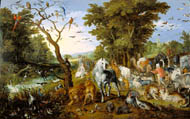 |
 |
 |
Grades/Level: Lower Elementary (K–2), Upper Elementary (3–5), Middle School (6–8)
Subjects: Visual Arts
Time Required: Short Activity
20 minutes
Author: J. Paul Getty Museum Education Staff
|
 |
 |
 |
 |
 |
Activity Overview |
This is a follow-up activity to the Getty Center Guided Lesson, Nature in Art. Students draw or sketch something from nature, using their imagination, and again from life, comparing and discussing their work to explore how artists carefully observe nature to represent it in works of art. |
 |
 |
 |
Learning Objectives |
Students should be able to:
• sketch a natural object from their imagination, and from observation.
• discuss the differences between drawing nature from their imagination, and from direct observation. |
 |
 |
 |
 |
 |
Materials |
• Use the same poster included in your pre-visit materials. |
 |
 |
 |
|
|
 |
 |
Activity Steps |
Overview: Students will draw a leaf using their imagination, and again from life.
They will then compare their work and discuss the different approaches.
Step 1: Display the Brueghel poster again for your students. Explain how the artist observed exotic and
unusual animals and how he often drew sketches of the animals from life. Discuss the idea that sometimes
artists closely observe nature before they record what they see.
Step 2: Pass out paper, pencils, and markers to the students. Ask your students to make a quick sketch of a leaf
from their imagination. Remind them that a sketch is not a final drawing but rather a practice drawing, so they
don't have to worry if they don't completely finish.
Step 3: Next, give students a second piece of paper and tell them that this time they will draw a leaf while they
look at it. Give each student a leaf (or they may go outside and gather their own). Ask them to look at the leaf as
closely as possible. Guide students through an examination of it; for example, "Slowly run your finger along the edge
of the leaf. Is it completely smooth? Are there points? How many points? Does the leaf have veins? What kind of pattern
do the veins make? Is the leaf all one color or does it have more than one color? Is the back the same as the front?
What is different about the two sides?"
Step 4: Ask students to make a sketch of their leaf. Students may choose to draw either the whole leaf or just a detail of it.
Step 5: Display the drawings and have a group discussion. Was drawing from imagination different than drawing from a live object?
How? Which did they like better? Why? Sum up by discussing how artists often are inspired to draw things from the world around
them, from nature. Looking closely is a skill that takes practice, and many artists spend their whole lives practicing how to see. |
 |
 |
 |
| The Entry of the Animals into Noah's Ark, Jan Breughel the Elder, 1613 |
 |
|
 |
 |
 |
Extensions |
Continue to explore the ways artists depict their natural surroundings. The following are useful resources for developing lessons on this topic.
Books:
Baumbusch, Brigitte. Looking at Nature: Art for Children Series. New York: Stuart, Tabori and Chang, 1999.
Blizzard, Gladys. Come Look With Me: Exploring Landscape Art with Children. Charlottesville, Va.: Thomason-Grant, 1992.
Blizzard, Gladys. Come Look With Me: Animals in Art. Charlottesville, Va.: Thomason-Grant, 1992.
Delafosse, Claude. Landscapes. New York: Scholastic, 1996.
Lynton, Norbert, et al. Looking into Paintings. Boston: Faber and Faber, 1985.
Where's the Bear? A Look-and-Find Book. Los Angeles: The J. Paul Getty Museum, 1997.
Web sites:
Art History Resources on the Web
ArtsEdge
The Gateway
National Gallery of Art (Washington, D.C.)-NGA Kids
Read, Write, Think |
 |
 |
 |

